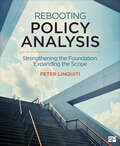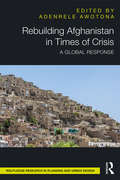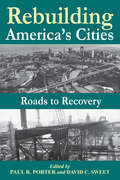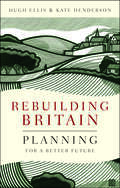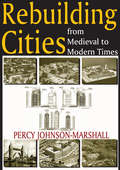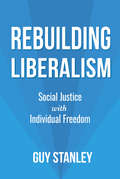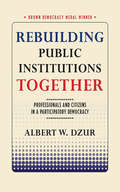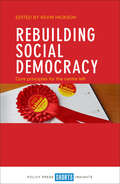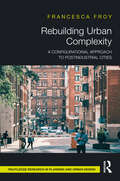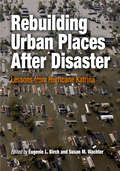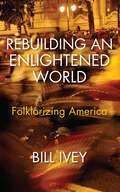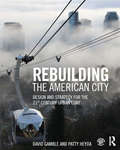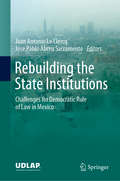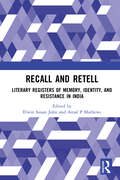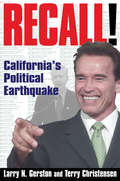- Table View
- List View
Rebooting Policy Analysis: Strengthening the Foundation, Expanding the Scope
by Peter D. LinquitiRebooting Policy Analysis: Strengthening the Foundation, Expanding the Scope is a savvy introduction to policy analysis that gets students thinking, not just about how decisions should be made, but how they are made. The text highlights practical skills needed to advise decision-makers on matters of public policy in ways that are well-informed and solutions-oriented, while managing limitations like time, resources, and information. In a world that has become increasingly complex and partisan, the strength of policy analysis rests not only in its classical academic methods, but on the development of a practical, analytic mindset.
Rebooting the American Dream: 11 Ways to Rebuild Our Country
by Thom HartmannThom Hartmann covers 11 straightforward solutions to America's current problems. At the core of each is a call to reclaim economic sovereignty and to wrest control of democracy back from the corporate powers that have hijacked both America and her citizens. What's particularly unique about Hartmann's solutions is that all have been proven to work. Every single one of his 11 steps either was historically part of what built America's greatness in the past (such as enforcing the Sherman Act and breaking up big corporations or returning to a tariff-based trade policy), or has worked well in other nations (like a national single-payer healthcare system -Medicare Part "E" for "Everybody"-or encouraging the growth of worker-owned cooperatives like the $6 billion Mondragon cooperative in Spain). From addressing the problem of a warming globe to the death of America's middle class to the loss of our essential liberties, Rebooting The American Dream shows how America can reclaim the vision of our Founders and the greatness we held both at home and abroad for over a century.
Rebooting the American Dream: 11 Ways to Rebuild Our Country
by Thom HartmannAmerica does not need an “upgrade.” For years the Right has been tampering with one of the best political operating systems ever designed. The result has been economic and environmental disaster. In this hard-hitting new book, nationally syndicated radio and television host and bestselling author Thom Hartmann outlines eleven common-sense proposals, deeply rooted in America’s history, that will once again make America strong and Americans—not corporations and billionaires—prosperous. Some of these ideas will be controversial to both the Left and the Right, but the litmus test for each is not political correctness but whether or not it serves to revitalize this country we all love and make life better for its citizens.
Rebranding China: Contested Status Signaling in the Changing Global Order (Studies in Asian Security)
by Xiaoyu PuChina is intensely conscious of its status, both at home and abroad. This concern is often interpreted as an undivided desire for higher standing as a global leader. Yet, Chinese political elites heatedly debate the nation's role as it becomes an increasingly important player in international affairs. At times, China positions itself not as a nascent global power but as a fragile developing country. Contradictory posturing makes decoding China's foreign policy a challenge, generating anxiety and uncertainty in many parts of the world. Using the metaphor of rebranding to understand China's varying displays of status, Xiaoyu Pu analyzes a rising China's challenges and dilemmas on the global stage. As competing pressures mount across domestic, regional, and international audiences, China must pivot between different representational tactics. Rebranding China demystifies how the state represents its global position by analyzing recent military transformations, regional diplomacy, and international financial negotiations. Drawing on a sweeping body of research, including original Chinese sources and interdisciplinary ideas from sociology, psychology, and international relations, this book puts forward an innovative framework for interpreting China's foreign policy.
Rebuild the Dream
by Van JonesIn the face of Wall Street’s recklessness, Washington’s negligence and the tea parties’ belligerence, President Obama’s former Green Jobs Czar, Van Jones sets forth a bold new manifesto that reclaims the American Dream on behalf of all working Americans
Rebuilding Afghanistan in Times of Crisis: A Global Response
by Adenrele AwotonaRebuilding Afghanistan in Times of Crisis provides academics and researchers interested in planning, urbanism and conflict studies with a multidisciplinary, international assessment of the reconstruction and foreign aid efforts in Afghanistan. The book draws together expert contributions from countries across three continents – Asia, Europe and North America – which have provided external aid to Afghanistan. Using international, regional and local approaches, it highlights the importance of rebuilding sustainable communities in the midst of ongoing uncertainties. It explores the efficacy of external aid; challenges faced; the response of multilateral international agencies; the role of women in the reconstruction process; and community-based natural disaster risk management strategies. Finally, it looks at the lessons learned in the conflict reconstruction process to better prepare the country for future potential human, economic, infrastructural and institutional vulnerabilities.
Rebuilding America's Cities
by PAUL R. PORTER, DAVID C. SWEETA growing cooperation between the public and private sectors indicates that the tasks of redevelopment are too large and complex for either sector to accomplish alone. Some people maintain that government can do few things right; others are equally distrustful of the private sector. As used here, the private sector is considered to be all that is not government. Each of the success stories illustrated is, in part, a ""road to recovery,"" although none appear to have been influenced by a purpose that broad.Paul R. Porter and David C. Sweet present stories of progress in self-reliance that concern neighborhood and downtown recoveries, school improvement, job generation, a regained fiscal solvency, novel financing techniques, helping tenants to become homeowners, and a successful venture in self-help and tenant management in crime-infested neighborhoods. The successes stem from the diverse community roles of Yale University, a medical center, the world's largest research organization, the Clorox Company, a gas company, an insurance company, a newspaper, neighborhood and downtown organizations, city governments and two religious organizations - the Mormon Church and the tiny Church of the Savior.These stories are located throughout the United States, including Akron, Baltimore, Brooklyn, Cincinnati, Cleveland, Columbus, Fort Wayne, Indianapolis, Milwaukee, New Haven, Oakland, Pittsburgh, St. Louis, St. Paul, Salt Lake City, Springfield, Mass., Tampa, and Washington, D.C. The editors have gathered the work of professionals known in the field of urban studies: James W. Rouse, Donald E. Lasater, Rolf Goetze, Dale F. Bertsch, Joel Lieske, Eugene H. Methvin, James E. Kunde, T. Michael Smith, Robert Mier, Carol Davidow, Jay Chatterjee, June Manning Thomas, Norman Krumholz, Larry C. Ledebur, and Robert C. Holland.
Rebuilding Britain: Planning for a Better Future
by Hugh Ellis Kate HendersonBritain faces extraordinary challenges, from climate change to growing inequality and global economics, but as a nation it has no plan for the future. This unique book asks a simple question: how can Britain organise itself, not just for survival but to build a fairer and sustainable society? The arguments refer to the high ambitions of those who pioneered the planning movement and campaigned for a clear set of progressive values, but whose drive for utopia has now been forgotten. The book takes a distinctive approach to exploring the value to society of social town planning and offers a doorway for how planning, both morally and practically, can help to meet key challenges of the 21st century. It challenges the widely held view that it’s impossible to achieve a better future by suggesting that there is real choice in how society develops and pointing to contemporary examples of utopia. This accessible book makes essential reading for students in the built environment and the wider social sciences who have an interest in UK and European examples of sustainable communities.
Rebuilding Cities from Medieval to Modern Times
by Percy Johnson-MarshallUnique in the literature of planners, architects, and urban officials, Rebuilding Cities is a compendium and analysis of the achievements of city planning from the ""Ideal City"" of Palmanova in 1593 to the innovative achievements of planners and designers of the twentieth century. As such, it is vital reading for anyone concerned with the problem of rebuilding and revitalizing cities after disasters--either of a human or physical decimation.Rebuilding Cities covers and includes medieval nuclei to urban sprawl; physical, economic, and social factors in planning; and the changing nature of components of cities incorporating elements from different periods in a single visual scheme. Also included are analysis of planning schemes from Indian and Greek visionaries; legislative and administrative changes needed for successful planning; the massive redevelopment that happened in London after World War Two; renewal schemes; and urban design and work throughout the world.The remarkable clarity and thoroughness of the book and its abundant illustrations clearly demonstrate the successes and failures of planning schemes and lays a solid groundwork for intelligent assessment of the goals and practical possibilities of city planning. Teachers and students of planning and architecture, professionals actively engaged in the field, and all who visualize a truly civilized urban environment will find this book immensely helpful and satisfying.
Rebuilding Expertise: Creating Effective and Trustworthy Regulation in an Age of Doubt
by William D. AraizaWhy the public has lost faith in government and how it can be restored In 1964, over three-quarters of Americans trusted the federal government to do the right thing all or most of the time. By 1980, that number had plummeted to 26 percent, and Ronald Reagan won a sweeping victory for the presidency while proclaiming that government was not the solution to our problems but was itself the problem. Today, Americans’ trust in public institutions is at near historic lows and “bureaucracy” and “big government” are pejorative terms.In Rebuilding Expertise, William D. Araiza investigates the sources of this phenomenon and explains how we might rebuild trust in our public institutions. Written in accessible and engaging language, the author examines the history of this deterioration of trust and reveals how politicians from Clinton to Trump have allowed that deterioration to continue, and, in some cases, actively encouraged it. Using an interdisciplinary approach, with insights from history, political science, law, and public administration, Araiza explores our current bureaucratic malaise and presents a roadmap to finding our way out of it, toward a regime marked by effective, expert regulation that remains democratically accountable and politically legitimate. A timely and indispensable read, Rebuilding Expertise makes clear what steps must be taken to regain public trust in our government.
Rebuilding Fiscal Institutions in Postconflict Countries
by Sanjeev Gupta Shamsuddin Tareq Benedict Clements Rina Bhattacharya Todd Mattina Alex Segura-UbiergoThe IMF's assistance to postconflict countries consists of 3 main elements: (i) technical assistance to rebuild capacity in key economic institutions; (ii) policy advice; (iii) financial and technical assistance in mobilizing donor support. The objective is to lay the basis for sustainable growth through institutional development and by addressing macroeconomic imbalances. This paper was prepared for a seminar of the IMF Executive Board. It discusses experiences in reestablishing fiscal management in those countries; reviews the challenges in rebuilding fiscal institutions based on experiences in 14 postconflict countries; and identifies key priorities in the fiscal area following the cessation of hostilities
Rebuilding Liberalism: Social Justice with Individual Freedom
by Guy StanleyA blueprint for constructing responsible liberalism Establishing liberalism that offers freedom and social justice is possible. Doing so requires examining the history of liberal ideas and culture over the last two centuries, followed by a major overhaul of existing systems, which includes coming to terms with liberalism’s past and its major limitations, as well as upgrading liberal economics and preparing for technological disruption. Rebuilding Liberalism combines a discussion about liberal ideas in a social context with political analysis, and builds a path forward that can ensure the survival of liberal society.
Rebuilding Public Institutions Together: Professionals and Citizens in a Participatory Democracy (Brown Democracy Medal)
by Albert W. DzurThe Laurence and Lynne Brown Democracy Medal is an initiative of the McCourtney Institute for Democracy at Pennsylvania State University. It annually recognizes outstanding individuals, groups, and organizations that produce exceptional innovations to further democracy in the United States or around the world.In this book, Albert W. Dzur argues that some of the most innovative and important work in democracy is taking place face-to-face and is being led by professionals who bring those involved into the decision making process. These "democratic professionals" create a culture that leads to better decisions and overcomes what he calls "civic lethargy." He focuses on how this democratic professionalism manifests itself in the operation of a wide range of public institutions, including schools and local government, as well as in the reform of our criminal justice system, from juries to prisons.
Rebuilding Social Democracy: Core Principles for the Centre Left
by Kevin HicksonThe British Labour Party is in crisis. A prolonged period of government between 1997 and 2010 saw the party intellectually exhausted. The subsequent leadership of Ed Miliband ultimately failed with the loss of the 2015 General Election, and the party now finds itself without a clearly defined set of aims and values. Rebuilding Social Democracy is the first major reappraisal of social democracy and thinking on the centre left since the election of Jeremy Corbyn. With a foreword by Peter Hain, it examines the key foundational principles of social democracy, including economic reform, equality, welfare, public service organisation, social cohesion, civil liberties, democratisation, and internationalism, in order to find a route back to political credibility for Labour. Written by leading academics in the field, it identifies the values and objectives needed to move the party forward, and revive left and centre-left thought and practice in Britain as an alternative to Conservative austerity.
Rebuilding Urban Complexity: A Configurational Approach to Postindustrial Cities (Routledge Research in Planning and Urban Design)
by Francesca FroyThis is a book about urban complexity – how it evolves and how it gets destroyed. It explores the structures of interdependency which underpin cities, where the many different “parts” (people, streets, industry sectors) interact to form an evolving “whole”.The book explores the evolution and destruction of complexity in one city – Greater Manchester – but also other post-industrial cities, including Sheffield and Newcastle, Detroit and New Haven. The focus is on the networked qualities of public urban space, and how street networks work as multiscale systems. The book also explores economic networks, and the evolving sets of interconnecting economic capabilities which help to shape urban economies. It demonstrates how cities evolve through processes of self-organisation – and concludes by considering how policy makers can best harness such processes as they rebuild urban complexity following insensitive planning interventions in the 1960s and 1970s.The book will appeal to anybody with an interest in cities, and how they work. It is interdisciplinary in scope, weaving in strands from architecture, economics, history, anthropology and ecology. It is written for academics but also non-academics, including urban planners, architects, local economic development actors and other policy makers.
Rebuilding Urban Places After Disaster
by Eugenie L. Birch Susan M. WachterDisasters--natural ones, such as hurricanes, floods, or earthquakes, and unnatural ones such as terrorist attacks--are part of the American experience in the twenty-first century. The challenges of preparing for these events, withstanding their impact, and rebuilding communities afterward require strategic responses from different levels of government in partnership with the private sector and in accordance with the public will.Disasters have a disproportionate effect on urban places. Dense by definition, cities and their environs suffer great damage to their complex, interdependent social, environmental, and economic systems. Social and medical services collapse. Long-standing problems in educational access and quality become especially acute. Local economies cease to function. Cultural resources disappear. The plight of New Orleans and several smaller Gulf Coast cities exemplifies this phenomenon. This volume examines the rebuilding of cities and their environs after a disaster and focuses on four major issues: making cities less vulnerable to disaster, reestablishing economic viability, responding to the permanent needs of the displaced, and recreating a sense of place. Success in these areas requires that priorities be set cooperatively, and this goal poses significant challenges for rebuilding efforts in a democratic, market-based society. Who sets priorities and how? Can participatory decision-making be organized under conditions requiring focused, strategic choices? How do issues of race and class intersect with these priorities? Should the purpose of rebuilding be restoration or reformation? Contributors address these and other questions related to environmental conditions, economic imperatives, social welfare concerns, and issues of planning and design in light of the lessons to be drawn from Hurricane Katrina.
Rebuilding an Enlightened World: Folklorizing America
by Bill IveyToday, the long-assumed belief in the permanence of an enlightened world is suddenly open to challenge. Human rights, participatory government, and social justice are losing global influence, and the world of ordinary people is pushing back against Enlightenment conceits. Accumulated anger links Taliban, Tea Party, and Trump, threatening women's rights, social justice, and democracy. To understand and counteract the threat to these ideas, we must set aside embedded explanations and embrace a new frame of observation and tolerance grounded in the power of belief, legend, and tradition. In Rebuilding an Enlightened World, Bill Ivey explores how folklore offers a unique and compelling new way to understand the underlying forces disrupting the world today. If we are to salvage the best of the Enlightenment dream and build a better future, we must begin to listen, patiently and inquisitively, in order to interpret the customs, norms, and traditional practices that shape all human behavior.
Rebuilding the American City: Design and Strategy for the 21st Century Urban Core
by David Gamble Patty HeydaUrban redevelopment in American cities is neither easy nor quick. It takes a delicate alignment of goals, power, leadership and sustained advocacy on the part of many. Rebuilding the American City highlights 15 urban design and planning projects in the U.S. that have been catalysts for their downtowns—yet were implemented during the tumultuous start of the 21st century. The book presents five paradigms for redevelopment and a range of perspectives on the complexities, successes and challenges inherent to rebuilding American cities today. Rebuilding the American City is essential reading for practitioners and students in urban design, planning, and public policy looking for diverse models of urban transformation to create resilient urban cores.
Rebuilding the State Institutions: Challenges for Democratic Rule of Law in Mexico
by Juan Antonio Le Clercq Jose Pablo Abreu SacramentoContemporary Mexico faces a complex crisis of violence and insecurity with high levels of impunity and the lack of an effective rule of law. These weaknesses in the rule of law are multidimensional and involve elements of institutional design, the specific content of the laws, particularities of political competition and a culture of legality in a country with severe social inequalities. This book discusses necessary institutional and legal reforms to develop the rule of law in a context of democratic, social and economic transformations. The chapters are organized to address: 1) The concept of the ‘rule of law’ and its measurement; 2) The fragility of the ‘rule of law’ in Mexico; 3) Structural reforms and implementation challenges; 4) Social exclusion and the culture of legality. The book addresses decision-makers, civil servants, consultants, scholars, lecturers, and students focusing on public policy, rule of law, sociology of law, legislative studies and practice, impunity, and areas of political philosophy. • The book presents an interdisciplinary and integrated approach for understanding the rule of law in Mexico, taking into account national particularities, the regional context and global comparisons.• Chapters discuss recent institutional reforms in Mexico from a critical point of view and explore possible next steps to achieve effective implementation.• This book addresses the links between a weak rule of law and social phenomena like insecurity, violence, corruption and democratic deficits.
Rebuttal
by Edited by Bill HarlowIn December 2014, the Senate Select Committee on Intelligence (SSCI) released a 500+ page executive summary of a 6,000 page study of the CIA's detention and interrogation of al Qa'ida terrorists. In early 2015 publishers released the study in book form and called it "the report" on "torture. " Rebuttal presents the "rest of the story. " In addition to reprinting the official responses from the SSCI minority and CIA, this publication also includes eight essays from senior former CIA officials who all are deeply knowledgeable about the program and yet none of whom were interviewed by the SSCI staff during the more than four years the report was in preparation. These authors of the eight essays are George Tenet, Porter Goss, Gen. Michael V. Hayden, USAF (Ret. ), John McLaughlin, Michael Morrell, J. Philip Mudd, John Rizzo, and Jose A. Rodriguez, Jr.
Recalibrating Reform
by Stuart Chinn"This book deals with the conservative aftermath of several eras of reform in American history by pointing to the phenomenon of "recalibration". It demonstrates the difficulty of achieving substantive political change in American politics; elements of the old political order always somehow find ways to survive and reassert themselves after reform has occurred"--
Recall and Retell: Literary Registers of Memory, Identity, and Resistance in India
by Elwin Susan JohnThis volume explores the instrumental role played by memory in our daily and collective narratives and the manifold ways in which it can destabilize those prevailing in India. It explores manifestations of memory and postmemory through written narratives, within India’s social, political, and cultural memoryscape. Drawing on archival research, oral history collection, and textual and critical analysis, the book endeavours to reconstruct Indian experiences in all their richness and diversity, while challenging dominant paradigms and expanding the boundaries of collective memory.An important contribution, this book will be of interest to students and scholars of history, memory studies, partition studies, sociology, cultural studies, English literature, decolonization, and South Asian studies.
Recall!: California's Political Earthquake
by Larry N. Gerston Terry ChristensenIn politics, as in so many other areas, California is unique. The state's economy - the largest in the nation, and sixth largest in the world - is given to dramatic swings. Its legislative system is often defined by gridlock on matters large and small. The use of the initiative, one of the tools of "direct democracy", has become commonplace. Over the years, California has had more than its share of political turmoil. But for pure melodrama, nothing matches the 2003 campaign to recall the state's sitting governor, Gray Davis. Recall! relates the latest and most dramatic chapter in the political history of the Golden State. The authors are recognized experts on California politics and regular local television political analysts. They provide fascinating coverage of the events leading up to Davis's replacement by bodybuilder-turned actor-turned politician Arnold Schwarzenegger; describe the large and colorful cast of characters involved in the special election; and demonstrate how California's one-of-a-kind mix of political, economic, and social circumstances made it all possible.
Recall!: California's Political Earthquake
by Larry N. Gerston Terry ChristensenIn politics, as in so many other areas, California is unique. The state's economy - the largest in the nation, and sixth largest in the world - is given to dramatic swings. Its legislative system is often defined by gridlock on matters large and small. The use of the initiative, one of the tools of "direct democracy", has become commonplace. Over the years, California has had more than its share of political turmoil. But for pure melodrama, nothing matches the 2003 campaign to recall the state's sitting governor, Gray Davis. Recall! relates the latest and most dramatic chapter in the political history of the Golden State. The authors are recognized experts on California politics and regular local television political analysts. They provide fascinating coverage of the events leading up to Davis's replacement by bodybuilder-turned actor-turned politician Arnold Schwarzenegger; describe the large and colorful cast of characters involved in the special election; and demonstrate how California's one-of-a-kind mix of political, economic, and social circumstances made it all possible.
Recall: A Red Ops Thriller (A Red Ops Thriller #1)
by David McCalebA veteran of an experimental military force is drawn back into service to save his family in this &“smart and well-plotted thriller&” series debut (Marc Cameron, New York Times bestselling author of Brute Force). To a trio of muggers, Tony &“Red&” Harmon looks like just another suburban dad. But when they demand his wallet at knifepoint, something snaps. In the blink of an eye, two muggers are dead, the third severely injured, and Red doesn't remember a thing. Once an elite member of the Det, a secret forces outfit whose existence is beyond classified, Red thought his active service was over. But now his memory is coming back—and a killing machine is returning to duty . . . Facing an unthinkable nuclear threat, a volatile international power play, and a personal attack against his family, Red has no choice. He must rejoin his old team, infiltrate the enemy camp, and complete the biggest mission of his life . . ."If you're looking for suspense, nonstop action, and a hero you can root for, The Red Ops series will clean your X ring."- David Poyer, USA Today bestselling author of Tipping Point and Onslaught
